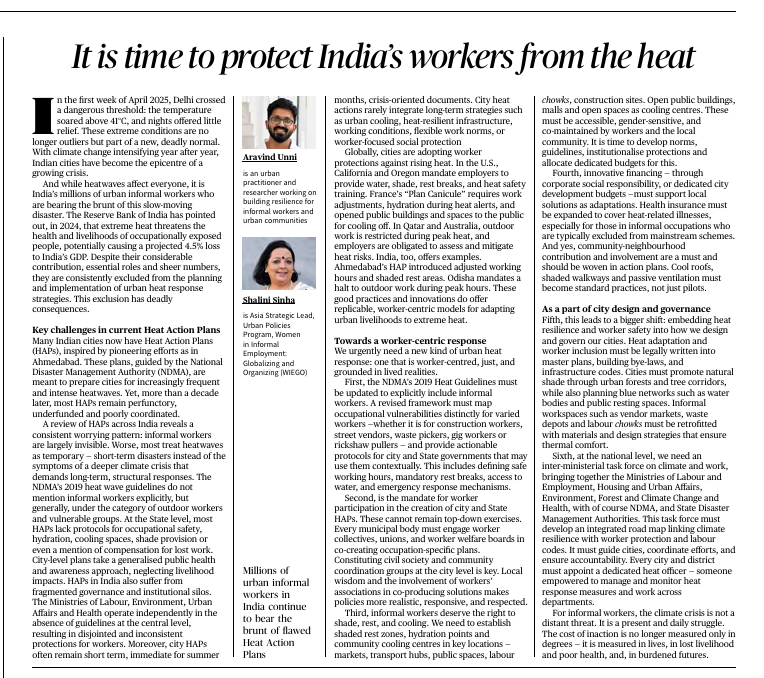GS Paper II – Governance
Q1. Heat Action Plans in India often fail to address the vulnerability of informal workers. Examine the need for a worker-centric approach in climate resilience strategies.
(10 marks)
Introduction:
India is facing record-breaking heatwaves, with Delhi touching 45°C in April 2025. Such extreme temperatures are no longer rare but a manifestation of accelerating climate change. According to RBI estimates, heat stress in 2024 could reduce India’s GDP by 4-5%, with millions of urban informal workers at the greatest risk.
Body:
A. Challenges Faced by Informal Workers during Heatwaves:
- Occupational Exposure:
- Work in open/semi-covered spaces: street vendors, construction workers, sanitation workers.
- Lack of Social Protection:
- Excluded from formal health insurance, paid leave, safety norms.
- Invisibility in Policy Frameworks:
- Most Heat Action Plans (HAPs) ignore informal workers.
- Health Risks and Livelihood Loss:
- Heat strokes, dehydration, productivity decline, income insecurity.
B. Inadequacies in Current Heat Action Plans (HAPs):
- Many HAPs are perfunctory, underfunded, and poorly coordinated.
- Focus remains on infrastructure and early warning, not on worker-centric protections.
- Lack of occupational heat-risk protocols or sector-specific solutions (e.g., for sanitation or vending).
C. Worker-Centric Adaptive Strategies:
1. Urban Design & Cooling Infrastructure:
- Public buildings as cooling centres.
- Green shaded pathways, cool roofs, and ventilated shelters.
- Enforce workplace cooling mandates (e.g., water, rest breaks, shaded areas).
2. Institutionalising Occupational Health:
- Classify heat as a workplace hazard.
- Include heat illness coverage in labour codes, ESIC, and health insurance schemes.
- Mandate employers to adjust work hours during extreme heat.
3. Localised Governance & Participation:
- Ward-level heat plans in consultation with street vendors, gig workers, and women’s groups.
- Ahmedabad and Odisha’s HAPs offer good models of decentralised planning.
4. Technology & Innovation:
- Heat early warning systems via SMS.
- Retrofitting markets, bus stops, worksites with low-cost local cooling
5. Inter-Ministerial Coordination:
- National Task Force linking:
- NDMA + Urban Ministry + Labour + Health + Environment for integrated planning.
- NDMA + Urban Ministry + Labour + Health + Environment for integrated planning.
- Integrate heat risk into Smart City Missions and urban mobility plans.
Conclusion:
Extreme heat is not just a climate crisis—it is a public health emergency, livelihood threat, and urban governance failure. Protecting the most vulnerable—India’s informal workers—requires a paradigm shift from disaster response to inclusive climate adaptation. Without a worker-centric lens, heatwaves will continue to widen the inequality gap.


